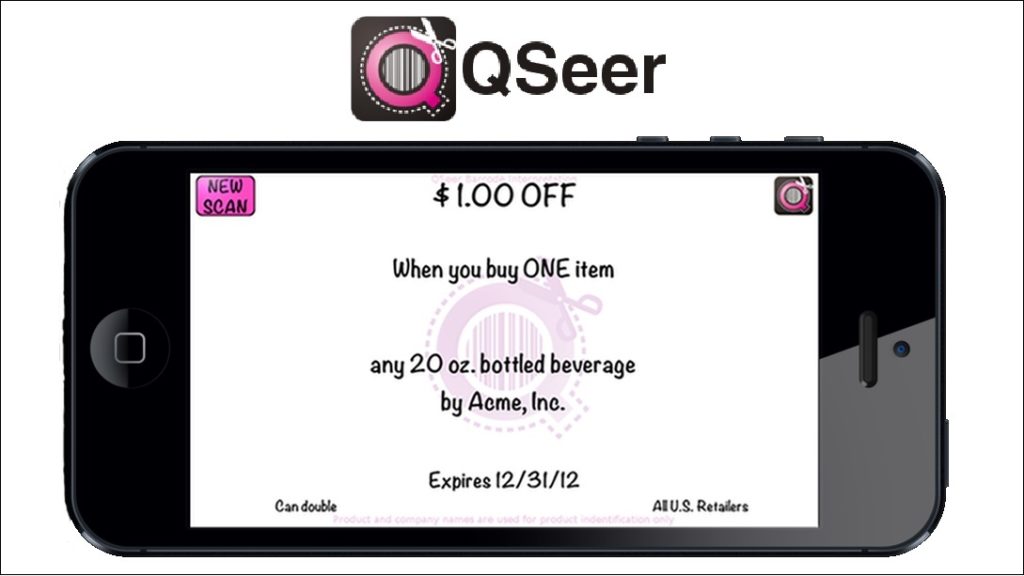
Coupon decoding is bad, we’ve been told – except when it’s not. That’s the shorthand version of what one smartphone app is trying to accomplish. And on an issue that most manufacturers see in terms of black and white, the app’s makers say there’s an awful lot of gray.
The “QSeer” app for iPhones and iPads is not the only one of its kind. But it is one of the newest – the most recent version launched earlier this year – and it has one of the most impressive pedigrees, with co-founders who have years worth of coupon industry experience. What they’ve created, though, might strike many of their former coupon industry colleagues as heresy. QSeer reads your coupons’ bar codes, and tells you how the coupons will scan at the store.
In other words, it decodes your coupons.
When “decoding” became a dirty word
If you consider yourself well-versed on coupon ethics, this likely strikes you as a very bad idea. Much like SnipSnap, the controversial app that promises to turn your paper coupons into mobile coupons, but is more like a smartphone-based photocopy machine, QSeer appears at first glance to offer a high-tech twist on a low-tech cheat.
Decoding coupons was a relatively obscure practice, before it gained particular notoriety on TLC’s “Extreme Couponing” TV series. Some of the more extreme couponers had discovered a weakness in many coupons’ bar codes, that allowed the coupons to “work” on other products made by the same manufacturer. In one of the most extreme and notorious examples, coupons for Crest Whitestrips valued at $10 or more would scan just fine on, say, a travel-sized tube of Crest toothpaste valued at a dollar or so. That meant big bucks for coupon decoders whose stores allowed overage.
The only problem is, it was completely unethical, if not worse. The rollout in recent years of the new GS1 DataBar style bar code, which is longer and contains much more information, was meant in part to help eliminate such loopholes, and ensure that coupons can be used only on the products for which they’re intended. The bar codes are also not nearly as easy to decode just by looking at them.
But now, that’s not necessary – there’s an app for that. QSeer is “the app that reads and decodes manufacturer coupon barcodes,” its website proclaims. “Simply use your iPhone’s camera function to scan a coupon’s barcode. QSeer interprets the barcode and displays the coupon terms in plain English.”
A consumer’s “right to know”?
So if coupon decoding is bad, how can this be good? QSeer’s creators insist that the app is on the up-and-up, and so are their intentions.
“Throughout the era of the old coupon barcoding system, we were definitely in the camp that ‘decoding coupons’ could only be used by consumers for deliberately misredeeming coupons,” QSeer co-creator Brad Cary told Coupons in the News. “With the DataBar’s introduction, our opinion of ‘decoding’ reversed. Now the consumer has a right to know how each coupon is going to be interpreted by the computer and whether a coupon will be accepted.”
Husband-and-wife team Brad and Katherine Cary developed the app together, after some time spent in the industry (“We both worked in brand management, which means that we have experience on the issuance side of coupons,” Brad said.) They, along with the rest of the industry, believed that the next generation of bar codes would solve many of the problems with the old bar codes. But when they took a closer look, they were shocked by what they discovered.
“We’ve found unbelievable quantities of errors” in coupons’ bar codes, Katherine said. For example, they discovered a 50-cents-off coupon that was actually coded to deduct 55 cents, and therefore wouldn’t double in stores that only double coupons up to 50 cents. Other coupons are coded to suppress doubling when the wording doesn’t actually specify “do not double” – or vice versa. Sometimes the discrepancies are in consumers’ favor, other times they’re not.
“I don’t know if the manufacturers are making mistakes, or if they’re doing it on purpose,” Katherine said. In all, the Carys claim to have discovered “a nearly 72% error rate” in which the information embedded in coupons’ bar codes doesn’t match what’s actually printed on the coupons themselves.
And that’s a problem, they say. The whole purpose of the DataBar is to put as much information in coupons’ bar codes as possible, thereby minimizing or eliminating the need for cashiers to have to read the coupons at all. That’s the reason many stores are adopting policies of “if it doesn’t scan, we can’t take it.” Even though cashiers are capable of reading the wording on coupons and manually entering them if they don’t scan correctly, the new bar codes are supposed to represent the final word.
Darned if you do, darned if you don’t
So, then, what if a bar code doesn’t match the actual wording on a coupon? Well, on the one hand, “if you follow the written word, then the coupon will be rejected at checkout,” Brad said. On the other hand, “if you adhere to the encoded terms, then some people will call this misredemption. We do not… How could it be ‘misredemption’ to redeem a coupon exactly as indicated in the DataBar?” QSeer, he explains, simply reads coupons’ bar codes the same way a cash register will, so there are no unpleasant surprises at the checkout.
There is, of course, a risk that some could use an app like QSeer for unseemly purposes. The FAQ on QSeer’s website acknowledges this, and is relatively nonjudgmental about it. Some coupons are coded to “scan regardless of what you purchase,” the FAQ reads, likely causing veteran coupon decoders to salivate. The FAQ weakly goes on to suggest that “when the typed words conflict with the bar codes, confusion may result. It is still best policy to purchase the items described in English on the coupon.”
When asked whether QSeer encourages or discourages such use, Brad acknowledged that “you could use QSeer for that purpose,” but described the app as similar to “a kitchen knife – 99% of the time, it’s used for the proper purposes.” But the 1% of the time it’s not – well, it’s not the knife manufacturer’s fault.
It’s that ambiguity that gives some industry professionals pause about QSeer, though most have stopped short of passing judgment on it. “As a general matter, GS1 US does not endorse or support any product or business practices that may harm consumers or competition or that may violate federal laws,” offered Shannon Sullivan, who represents the company that administers the GS1 system in the United States. The Coupon Information Corporation cited its own coupon best practices, which states that “each coupon is a contract and should be used only for the item described in writing on the coupon itself. Using a coupon for any product other than the one intended is a type of fraud similar to shoplifting.”
The Carys don’t dispute the notion that a coupon is a contract. But “the bar codes regulate how the coupon will be read and processed through the system, making those bar codes a material portion of the coupon contract,” they argue. Therefore, “you have the right to read and understand every part of every contract that you accept.”
Your coupons are watching you
Some of those “contracts” also include tracking information, they point out, that is not otherwise disclosed on the coupon. “Every major manufacturer has added tracking numbers to some of their coupons. These numbers allow manufacturers to view exactly what you are buying and when,” QSeer’s FAQ reads. “They are collecting data about you with these coupons. You have the absolute right to know if a coupon is tracking you, and the only way to tell is to read the bar codes!”
If some remain unconvinced that decoding coupons should be encouraged in this way, the Carys say they understand. “It’s a very gray, difficult issue,” Katherine allowed. But as a way of showing their honorable intentions, they say, they’re currently developing a version of the app for manufacturers. Companies that commission coupons, and outsource the creation of the bar codes, may not even know how their own coupons will scan at the store. A “QSeer Pro” would allow them to easily read their coupons’ bar codes, and determine whether they’re coded the way they want them to be.
Ultimately, the Carys claim it’s not about trying to beat, or cheat, the system. “What we really want is for the manufacturers to do it right,” Katherine said. The only question is whether empowering consumers to decode coupons will pressure manufacturers to improve their practices – or merely encourage them to tighten things up and add even more restrictions to their coupons, in an effort to gain back the upper hand. The Carys know which they’d like to happen. Only time will tell if their prediction pans out.











Do you guys not realize this app is used in the downlow? It’s not meant to tell the cashier you use it and why a different product works instead of the wording on the coupon. Be smart, you rookie couponer!!! Ugh….
People like you are the reason it becomes harder for others to accomplish what we’ve worked hard to do. This type of “hobbie” is not for the faint of heart. This takes time, skill, dedication and patience along with trial and error.
Please don’t tell cashiers you use qseer!!!
I am a beginner on extreme couponing and it is very hard to be legit but it is possible just for the heck of it today I went and bought 20 packages of stay free pads for free because it said any stay free product not going to say where I got it but they were technically legit…so like I said it can be done…by the way would have paid 80.00…didn’t pay s*#t…and as for cashiers thanks for the concern for the couponing biz but I honestly think that their just jealous that we walk out with free stuff….it takes alot of patience, organization, and if your as legit as you can be you won’t have any problems….bring back double coupons and no one will be cheating that would be alot of fun!!!
I work in retail. I have scanned coupons where the customer did not purchase the required item(s) I explain to the customer and that I would not be able to accept said coupon and that is a type of fraud. Most are understandi ng but what makes it most difficult is when the customer read online somewhere it “works” and refuse to understand it is in essence shoplifting and but scanning your membership card and commiting this fraud you are not “getting away” with anything but only being watched as a shoplifter.
I urge anyone using coupons to please understand why the prices on items like razors/refill blades would be more reasonable if we all did our part as consumer and follow the guidelines of the “contract”. And remember stealing is stealing!! And honesty is always the best policy.
First, coupons represent only a small fraction of the tender used to purchase merchandise. A tiny fraction of that is incorrect, that is, perceived by the point-of-sale machine as valid when not. And then, even if it is invalidly accepted, the store can still get reimbursed simply by submitting it. Moreover, if the POS accepts it when it shouldn’t, then there is a problem with the POS software. This is the store’s responsibility – not the customer’s.
There is no “fraud”, as you would term it. That’s ridiculous. You are just venting your hostility toward your customers, or perhaps you are disguising some of your own guilt. The main source of loss for a store is employee theft.
Cvs says the qseer app is not legit….they would not honor my coupon…..could you please advise me on this. They said they could only use the coupon on the items shown on the coupon. The nivea coupon said hand lotion but when I scanned it it said could be used on the nivea lip care.
I don’t think a cashier will ever understand what QSeer is.Most stores like Walmart just want the coupon to beep and not deal with the hassle even if you have the correct thing on the coupon and it does not go through.
then that’s what you have to use it for, if the coupon had said on any nivea product then you could’ve use it on the nivea lip care